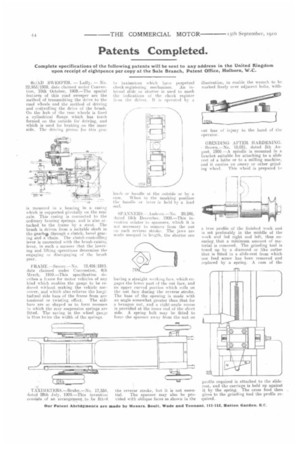Patents Completed.
Page 24

If you've noticed an error in this article please click here to report it so we can fix it.
Complete specifications of the following patents will be sent to any address in the United Kingdom upon receipt of eightperice per copy at the Sale Branch, Patent Office, Holborn, W.C.
ROAD SWEEPER. — Lathy, — No. 22,933;1909, date claimed under Convention, 10th October, 1908.—The special features of this road sweeper are the method of transmitting the drive to the road Wheels and the method of driving and controlling the drive of the. brush. On the 'hub of the rear wheels is fixed a cylindrical flange which has teeth formed on the outside for driving, and which is used for braking on the inner side. The driving pinion for this gear is mounted in a bearing in a casing which is supported pivotally on the rear axle. This casing is connected to the ordinary bearing springs, and is also attached to the frame by a strut. The brush is driven from a suitable shaft in tho gearbv. through a clutch, bevel gearing and a chain. The clutch-controllinglever is connected with the brush-raising lever, in such a manner that the lowering and lifting operations determine the engaging or disengaging of the brush gear..
FRAME.—Saurer.—No. 12,41611910. date claimed under Convention, 4th March, 1910.—This specification decribes a frame for motor vehicles of any kind which enables the gauge to be reduced without making the vehicle narrower, and which also relieves the longitudinal side bars of the frame from any
torsional or twisting effect. The side liars are so shaped as to form recesses in which the rear suspension springs are fitted. The saving in the wheel gauge is thus twice the width of the springs.
T AXIld ETERS.—Bruhn.—No. 17,564, dated 28th July, 1909.—This invention consists of an arrangement to be fitted to taximeters which hai c perpetual cheek-registering mechanism. An internal slide or shutter is used to mask the indications of the check register from the driver. it is operated by a knob or handle at the outside or by a
maul. When in the masking position the handle Or lever is held by a lead seal, SPANNERS.--Amborra—No. 29.246, dated 14th December, 1909.—This invention relates to spanners, which it is not necessary to remove from the nut on • each reverse stroke. The jaws are made unequal in length, the shorter one having a straight working btee, which engages the lower part tif the nut face, and all upper curved portion which rolls on the nut face during the reverse stroke. The base of the opening is made with an angle somewhat greater than that for a hexagon nut, and a right-angle recess is provided at the inner end of the short side. A spring bolt may be fitted to force the spanner away from the nut on
the reverse stroke, but it is not essen
tial. The spanner may also be provided with oblique faces as shown in the
illustration, to enable the wrench to be worked freely over adjacent bolts, with out fear of injury to the hand of the operator.
GRINDING AFTER HARDENING. Brown.—No. 18,051, dated 5th August, 1909.—A spindle is mounted in a bracket suitable for attaching to a slide rest of a lathe or to a milling machine, and it carries an emery or other grind ing wheel. This wheel is prepared to a true profile of the finished work and is set preferably in the middle of the work and fed right and left, thus ensuring that a minimum amount of material is removed. The grinding tool is trued up by a diamond or like cutter that is fitted in a slide-rest from which one feed screw has been removed and replaced by a spring. A cam of the profile required is attacl ed to the sliderest and the carriage is held up against it by the spring. The cross feed then gives to the grinding tool the profile required.
























